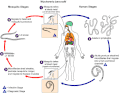File:Wuchereria bancrofti LifeCycle.gif
Wuchereria_bancrofti_LifeCycle.gif (513 × 435 pixels, file size: 33 KB, MIME type: image/gif)
File history
Click on a date/time to view the file as it appeared at that time.
| Date/Time | Thumbnail | Dimensions | User | Comment | |
|---|---|---|---|---|---|
| current | 14:15, 5 November 2008 |  | 513 × 435 (33 KB) | Lycaon | Watermark removed |
| 21:02, 14 May 2006 |  | 513 × 435 (36 KB) | Patho | {{Information| |Description=Filariasis [Brugia malayi] [Brugia timori] [Loa loa] [Mansonella ozzardi] [Mansonella perstans] [Mansonella streptocerca] [Onchocerca volvulus] [Wuchereria bancrofti] Life cycle of Wuchereria bancrofti Different species |
File usage
The following pages on the English Wikipedia use this file (pages on other projects are not listed):
Global file usage
The following other wikis use this file:
- Usage on ceb.wikipedia.org
- Usage on de.wikipedia.org
- Usage on de.wikibooks.org
- Usage on fr.wikipedia.org
- Usage on hu.wikibooks.org
- Usage on nn.wikipedia.org
- Usage on pl.wikipedia.org
- Usage on sv.wikipedia.org


